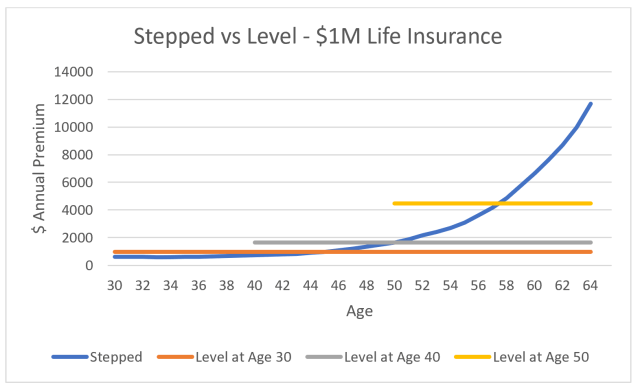Stepped vs Level Premiums
Most Premiums in Australia are stepped but Which is Better?

Pros and cons of Stepped and Level Premiums
In Australia it is estimated around 3 out of 4 retail life insurance policies have been purchased with a “stepped” rather than a “level” premium. This includes TPD, Trauma and Income Protection policies.
“Stepped” premiums are often preferred because they are cheaper at the outset, however they become more expensive over time. This can lead to policies being cancelled just when they are needed the most.
“Level” premiums, on the other hand, can work out cheaper over the long term and allow cover to be maintained for longer.
What is the difference between Stepped and Level premiums?
Stepped Premium
A stepped premium means that the premium will “step up” over time as you age and your mortality risk increases. The premium will start out cheap when you are young, but will increase each year and become quite expensive when you are older.
Level Premium
A level premium, on the other hand, will not increase with your age. The premium is “levelled” or averaged over a period of time, usually until you turn 65 or 70. A level premium will cost more than a stepped premium initially. However, the level premium will not increase with age like the stepped premium, meaning you may pay less over the long term.
Does this mean that a Level premium will never increase?
No, this is not the case.
Level premiums, like stepped premiums, can go up for a number of reasons including:
- When your cover increases due to indexation. Where your policy has CPI indexation you will be offered an automatic increase to your cover each year and will have to pay for the extra cover. Some policies use the level premium from the start of the policy for these indexation increases (these are called “True Level” policies). Other policies charge the level premium applicable to your age at the time the cover is increased, which will be higher each year as you age.
- If you ask for an increase in your cover. In this case the extra cover is always priced at the level premium applicable to your age at the time of the increase.
- Should the insurer decide to increase their rates. Level premiums are not guaranteed and therefore can be increased if the insurer decides to increase their premiums e.g. in response to rising claims.
- If the government imposes a tax or increases its charges. If stamp duty or other taxes applicable to the policy are increased by the government these will be passed on to you.
- At the end of the Level period. A premium will usually only be level for a fixed period, such as to age 65 or age 70. At the end of this period, the level premium will revert to the applicable stepped premium for your age. This can result in a considerable jump in premium.
How much does a Level Premium cost compared to a Stepped Premium?
A level premium will generally cost more the older you are when you take the policy out. The graph shows what a level premium to age 65 will cost if taken out as a 30 year old, 40 year old and 50 year old. This is contrasted to the stepped premiums which will be paid over time.
From the graph it is clear that level premiums are lower if taken out at a younger age. In the above example if a level premium is taken out by a 30 year old they will pay $987 a year, whereas a level premium taken out by a 50 year old will cost $4460 a year.
It is also true that the level premium will not be as expensive relative to the comparable stepped premium if taken out at a younger age. In the above example, at the start of the policy the level premium was:
- For the 30 year old – around 60% higher than stepped
- For the 40 year old – around 120% higher than stepped
- For the 50 year old – around 170% higher than stepped

Premiums will vary from insurer to insurer and from product to product. However, it is generally true (over the age of 30), that level premiums will cost less, both in an absolute dollar sense and also relative to a stepped premium, if taken out as young as possible.
How do you find out what level premiums are available? Only stepped premiums are displayed on our website when using Compare Quotes. However, once you have entered your cover details, you can request a Level Premium Comparison Report by clicking “Ask us for help” on the quotes page.
Stepped vs Level Premiums – which one is better?
When comparing stepped and level premiums it is important to compare the breakeven period i.e. how long it will take before a level premium will work out cheaper than having a stepped premium.
Importantly the breakeven is NOT the crossover point when the stepped premium moves above the level premium, which will happen at some point as your age increases. This is because, for the years prior to this, you will have been paying a higher level premium.
The true breakeven period is when the cumulative level premiums paid become less than the cumulative stepped premiums paid.
Although the breakeven period is longer for the 30 year old, the potential savings are much higher, as they will have from age 53 to age 65 to reap savings compared to a stepped premium.
In the example above the breakeven periods are as follows:
| Age at start | Breakeven period | Breakeven age | Potential savings if held to age 65 |
| 30 year old | 23 years | 53 | $58,700 |
| 40 year old | 17 years | 57 | $46,000 |
| 50 year old | 13 years | 63 | $10,000 |
How to choose between a Level Premium and a Stepped Premium?
In order for a level premium to have potential savings compared to a stepped premium, your expected time horizon needs to be longer than the breakeven period.
For the 30 year old in the example above, if they intend holding their policy till retirement at age 65 then their time horizon would be 35 years which is greater than the breakeven period of 23 years. They can potentially make savings of $58,700 over the remaining 12 years with a level premium compared to a stepped rate which is increasing rapidly with age.
For the 50 year old, also intending to hold their cover till age 65, their time horizon is 15 years. This is only slightly longer than the breakeven period of 13 years. There would only be a 2 year period for savings to be made and the potential savings are lower at $10,000. If the policy was terminated earlier, e.g. at age 60, the level premium would have cost around $12,200 more.
An individual’s expected time horizon for their policy will depend upon their goals for having insurance cover. If the 30 year old’s main goals were to cover their mortgage and their children until they are adults, they might have an expected time horizon of only to age 50. With this time horizon they would be better off with a stepped premium by around $2,650.
A complicating factor is that neither stepped nor level premiums are guaranteed and therefore premium projections cannot be relied upon. In the last seven years many insurers have increased the premiums on their level policies, in some cases by as much as 30%. While these insurers may have also increased their stepped premiums, the net effect over time has been to push overall breakeven periods longer.
Is there a future for Level Premiums?
With falling interest rates, the profitability of level premiums has declined for insurers. This is on top of a general decline in profitability due to rising claims.
In reaction to this, some Australian insurers have stopped offering level premiums. Others have limited the availability of level premiums to certain age groups such as under 45s only. Further increases to level premiums also cannot be ruled out.
In December 2022 ASIC and APRA wrote to insurers expressing their concerns about recent premium increases. They asked insurers to consider the appropriateness of the label “level” if there was not a high degree of confidence that premiums would be stable.
In an update in December 2023 ASIC and APRA highlighted that, over the period 2017 to 2023, increases in base premium rates for level premiums were generally larger than for stepped premiums. This is despite consumer expectations that level premiums would be more stable than stepped.
Given this, you may well question whether it is a good idea to commit to a long term level premium.
Ultimately you need to consider your individual circumstances when considering a level premium i.e. –
- Your age
- Your expected time horizon
- Affordability of premiums
- Breakeven period for cumulative stepped and level premiums
- Ability to cope with potential insurer re-ratings of premiums
- Preference for cashflow now versus the future, particularly if salary increases are expected to cover increasing stepped premiums over time
- Desire for flexibility to reduce covers or change insurers in the future
Alternatives to traditional level premiums
A combination of stepped and level premiums may suit your goals. If there is a “core” amount of cover that you want to maintain long term i.e. to age 65 or 70, this might be suited to a level premium. Other cover for short term goals can then be taken out with a cheaper stepped premium, and the cover reduced or cancelled as the premium increases with age.
Short period level premiums are commonly available in other countries such as the UK. In Australia, there are a few insurers who offer a range of “Term Level” premiums for 5, 10 or 15 years. At the end of the term, the policy reverts to a stepped premium. Term Level premiums are more affordable than premiums which are level to age 65 or 70 and can offer premium certainty for those who have short time horizons or budgetary constraints.
There are also some insurers who also offer hybrid or combined options. One example of this is the “Optimum” premium offered by AIA which acts like a stepped premium in the early years of a policy but behaves like a level premium in the latter years of the policy which is when premiums may be increasing the sharpest. This is an in-between option, providing those who can’t afford a level premium in the initial years with a less expensive option of limiting future age-related premium increases.
While the savings from these alternatives may not be as large as a traditional level premium, they may help flatten future premiums increases as you age and this may help avoid having to cancel all your cover at a time when the probability of claiming may be the highest.
This article provides general information only. Before considering a level premium you should read the insurer’s Product Disclosure Statement and seek advice on your personal situation to determine whether this is appropriate for your goals, needs and financial situation. Complete our online Fact Find at Get Advice to have a qualified Insurance Watch adviser contact you to discuss your options.
